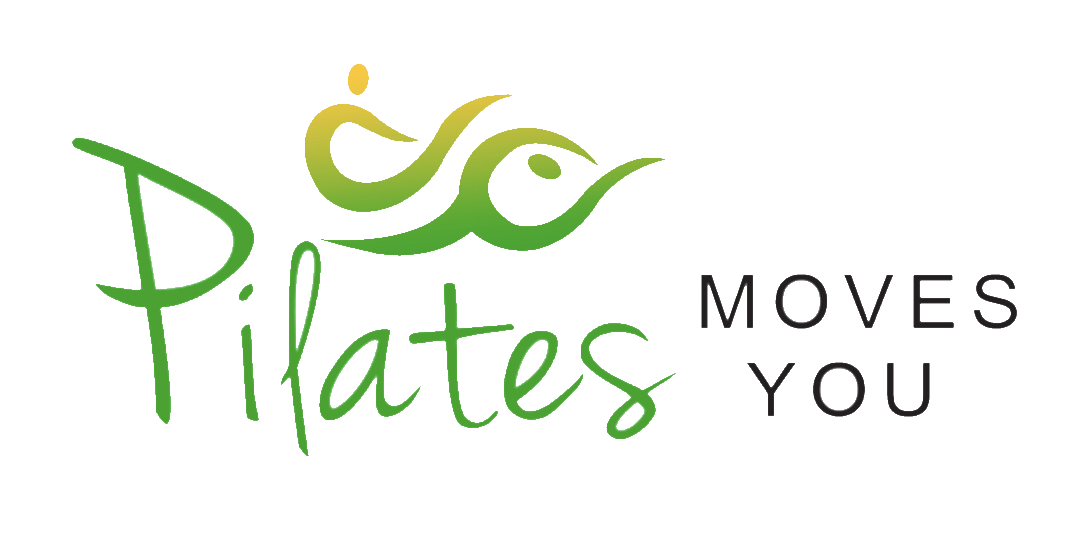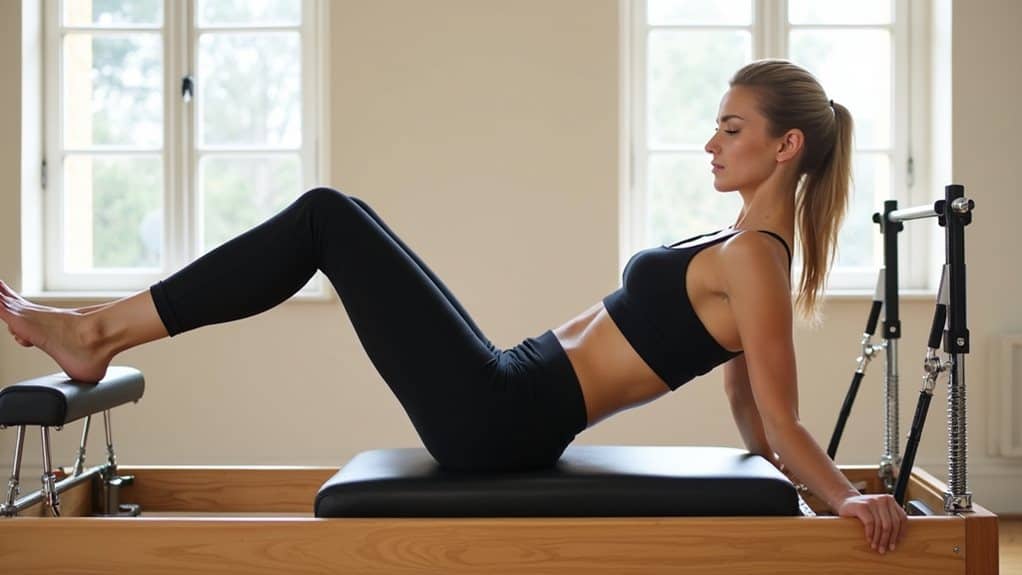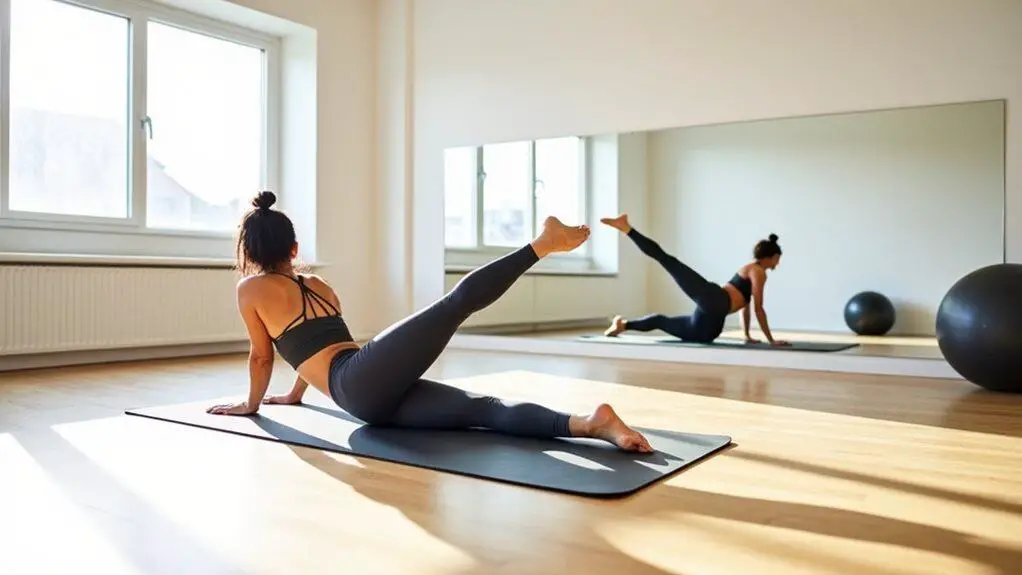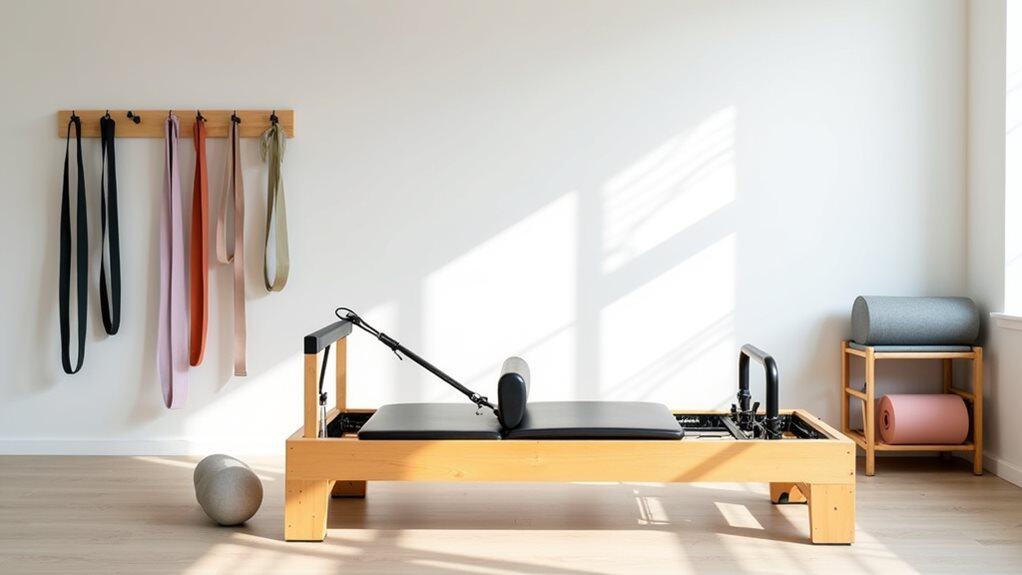Pilates Reformer workouts strengthen your core, improve your posture, and enhance full-body muscle definition through precise spring-loaded resistance training. You’ll develop better balance, coordination, and flexibility while protecting your joints through controlled, low-impact movements. The equipment’s adjustable settings allow for personalized progression as you build strength and stability. This scientifically-validated exercise method helps prevent injuries while creating lasting improvements in your biomechanical function. Additional benefits await below.
Core Strength and Stability Enhancement
The Pilates Reformer effectively targets core musculature through controlled resistance and spring-loaded movements.
You’ll engage your deep stabilizing muscles as you move through precise exercises designed to strengthen your abdominal wall, lower back, and pelvic floor.
Through specialized core stabilization techniques, you’re training your body to maintain proper spinal alignment while performing dynamic movements.
The reformer’s adjustable spring tension allows you to progressively challenge your core strength as you advance.
Customizable resistance levels on the Pilates reformer create opportunities for continuous core strengthening as your abilities improve over time.
When combined with pilates breathing methods, these exercises activate your transverse abdominis and multifidus muscles, essential for trunk stability.
You’ll develop enhanced proprioception and neuromuscular control while performing exercises like the hundred, teaser, and long spine.
These movements integrate core activation with whole-body awareness, improving your overall stability and movement efficiency.
Improved Posture and Body Alignment
While traditional exercise methods often overlook postural mechanics, Pilates Reformer workouts specifically target your body’s alignment through precise movement patterns and feedback mechanisms.
The reformer’s spring-based resistance system helps you identify postural imbalances and trains your muscles to support proper spinal alignment.
You’ll develop enhanced postural awareness as the reformer’s carriage provides immediate feedback when your body deviates from ideal alignment.
The machine’s straps and pulleys guide your movements in anatomically correct planes, reinforcing neutral spine positioning and balanced muscle engagement.
Through consistent practice, you’ll retrain compensatory movement patterns that may have developed from poor posture habits.
The reformer’s controlled environment allows you to focus on maintaining proper form while strengthening the muscles responsible for sustaining healthy alignment throughout daily activities.
Full-Body Muscle Toning and Definition
Through controlled resistance movements on the Reformer, you’ll engage multiple muscle groups simultaneously to achieve thorough toning from your core outward through your extremities.
Your arms and shoulders develop lean definition through pushing and pulling exercises, while your legs gain functional strength through precise spring-loaded movements targeting your quadriceps, hamstrings, and calves.
The Reformer’s unique system promotes balanced muscular development by working both agonist and antagonist muscle pairs through their full range of motion, helping you achieve symmetrical strength and definition throughout your body.
Core and Arm Sculpting
Reformer-based exercises targeting core stability and upper extremity strength create an interconnected chain of muscle activation, enhancing both proximal and distal control.
You’ll engage in movements that challenge your arm endurance while maintaining constant core engagement through resistance-based spring tension.
The carriage’s dynamic platform requires you to stabilize your trunk as you perform exercises like long spine and teaser variations.
During upper body exercises, you’ll coordinate scapular stability with core activation, developing refined motor control throughout your kinetic chain.
The spring resistance system allows for progressive loading of both core and arm muscles, adapting to your strength capabilities.
This integration of core-to-extremity control helps develop functional movement patterns that transfer to daily activities and athletic performance.
Lower Body Strength Benefits
Lower body conditioning on the Reformer creates extensive muscular adaptations across multiple joint systems. The spring-loaded carriage provides progressive resistance that can enhance your hamstring activation and glute engagement through a full range of motion. The controlled movements target both superficial and deep muscle groups.
- Eccentric muscle control development through decelerated movements against spring tension
- Enhanced proprioceptive awareness during unilateral leg exercises
- Improved neuromuscular coordination across hip, knee, and ankle joints
- Strategic glute engagement patterns through hip extension exercises
You’ll experience targeted muscle recruitment through precise positioning and spring adjustments. The Reformer’s sliding carriage allows for smooth shifts between exercises while maintaining ideal joint alignment.
This systematic approach to lower body strengthening supports functional movement patterns and helps prevent compensatory mechanisms that can lead to muscle imbalances.
Balanced Muscle Development
While many exercise modalities target isolated muscle groups, Pilates Reformer workouts excel at promoting balanced muscular development across the entire kinetic chain.
You’ll experience enhanced muscle symmetry as the reformer’s spring-based resistance system engages both your dominant and non-dominant sides equally during each movement pattern.
The reformer’s versatile design allows you to address muscular imbalances that may have developed from injury recovery or repetitive daily activities.
Through controlled movements and adjustable resistance, you’ll strengthen underactive muscles while simultaneously releasing overactive ones. This balanced approach helps prevent compensatory movement patterns that could lead to future injuries.
The reformer’s support system enables you to maintain proper form throughout each exercise, ensuring you’re developing strength and flexibility in proper proportion across all major muscle groups.
Low-Impact Joint Protection and Mobility
The Pilates Reformer’s controlled, spring-assisted movements allow you to strengthen your muscles while maintaining safe ranges of motion for your joints.
You’ll develop functional flexibility through progressive resistance that supports rather than stresses your joints during exercise.
The equipment’s sliding carriage helps you achieve greater mobility by guiding your body through biomechanically correct movement patterns that respect your natural joint alignments.
Safe Joint Movement
Moving safely through joint ranges protects your body during Pilates Reformer exercises. The equipment’s spring resistance system supports proper joint mobility while allowing you to maintain control through each movement pattern. Through guided resistance, you’ll develop better awareness of your body’s natural joint mechanics.
- Your joints move through controlled ranges of motion as the carriage glides smoothly, reducing impact and stress on cartilage.
- The adjustable spring tension helps you progress gradually while maintaining safe movement patterns.
- Straps and handles provide stability during exercises, allowing precise joint alignment.
- The platform’s design enables you to work within your anatomical limitations while gradually increasing mobility.
This measured approach to joint movement helps prevent overextension while building strength and flexibility in a biomechanically sound manner.
Building Functional Flexibility
Practicing Pilates Reformer exercises develops functional flexibility through controlled lengthening of muscles and fascia.
You’ll enhance your range of motion using dynamic stretching techniques that integrate resistance with the reformer’s spring system, promoting balanced muscle development.
The reformer’s mobility drills target specific muscle groups while maintaining joint stability, allowing you to achieve greater flexibility without compromising structural integrity.
As you move through controlled exercises, you’ll improve proprioception and neuromuscular coordination, essential components for functional movement patterns.
These controlled stretching sequences activate your body’s natural flexibility potential while protecting your joints from excessive stress.
Your muscles lengthen under ideal tension, creating lasting improvements in flexibility that transfer directly to daily activities and athletic performance.
The reformer’s adjustable resistance guarantees you progress safely while building sustainable mobility.
Enhanced Flexibility and Range of Motion
Regular sessions on a Pilates Reformer greatly enhance your joint mobility and muscle flexibility through controlled, spring-assisted movements.
The apparatus’s unique design facilitates dynamic stretching and mobility drills that target multiple muscle groups simultaneously, promoting ideal range of motion throughout your kinetic chain.
Key biomechanical benefits include:
Understanding the biomechanical advantages helps maximize your Pilates practice, enhancing both body awareness and movement efficiency through systematic training.
- Progressive lengthening of shortened muscles through eccentric loading, allowing for safer and more effective stretching
- Increased neuromuscular coordination during multi-planar movements that enhance joint articulation
- Development of functional flexibility patterns that directly transfer to daily activities and sports performance
- Integration of core stabilization with mobility drills, ensuring balanced muscle development while preventing overstretching
The spring resistance system provides adaptive support throughout each movement, enabling you to safely explore and expand your natural range of motion limits.
Better Balance and Coordination Skills
The Pilates Reformer’s dynamic spring system advances beyond flexibility training to create an ideal environment for neuromuscular development of balance and coordination.
You’ll engage your core stabilizers while performing exercises on the moving carriage, which challenges your proprioception and spatial awareness.
Through progressive balance training sequences, you’ll develop enhanced postural control as your body adapts to the constantly shifting resistance levels.
The reformer’s coordination drills require precise movement patterns that integrate your upper and lower body.
As you master these controlled movements, you’ll strengthen the neural pathways between your brain and muscles, improving your overall motor control and equilibrium.
This mind-body connection becomes particularly beneficial in daily activities and can help reduce your risk of falls, especially as you age.
Injury Prevention and Rehabilitation Benefits
Since Pilates Reformer exercises provide controlled resistance throughout their full range of motion, they’re particularly effective for preventing injuries and supporting rehabilitation protocols. The equipment’s design allows you to strengthen muscles while maintaining proper alignment and joint stability.
- You’ll develop balanced muscle engagement around joints, reducing your risk of overuse injuries and improving your body’s biomechanical efficiency.
- The reformer’s spring resistance system helps you progress safely through rehabilitation techniques, adapting to your recovery needs.
- You’ll strengthen stabilizing muscles that protect vulnerable joints, particularly beneficial for back, knee, and shoulder injury prevention.
- The controlled movements allow you to build strength without compromising healing tissues, making it an ideal choice for post-injury rehabilitation.
These injury prevention benefits make Pilates Reformer workouts a valuable tool in both prehabilitation and rehabilitation settings.
Mind-Body Connection Development
While executing movements on the Pilates Reformer, practitioners develop heightened neuromuscular awareness through focused attention on breath coordination, muscle activation patterns, and postural alignment.
The mindfulness practice cultivated during reformer sessions enhances your proprioceptive feedback, allowing you to better sense your body’s position in space.
Through deliberate breath awareness and controlled movements, you’ll strengthen the neural pathways between your brain and muscles.
This enhanced mind-body connection helps you identify and correct movement compensations that may lead to poor biomechanics.
You’ll learn to engage specific muscle groups with precision while maintaining ideal joint positioning.
The reformer’s spring resistance system provides constant feedback, helping you develop greater kinesthetic awareness and movement efficiency that transfers to daily activities and athletic performance.
Personalized Resistance Training Options
Building upon your enhanced mind-body awareness, customizable resistance options on the Reformer allow precise load adjustments to match your strength levels and therapeutic needs.
Your personalized routines can be modified through adjustable settings that accommodate various fitness levels and rehabilitation goals.
- Spring resistance systems let you progress gradually from light to heavy loads, supporting both injury recovery and strength development.
- Adjustable foot bar positions enable ideal biomechanical alignment for different body types and movement patterns.
- Removable box and platform configurations create varied exercise angles for targeting specific muscle groups.
- Customizable strap lengths help maintain proper form while accommodating individual limb lengths and mobility restrictions.
These adaptable features guarantee your Reformer workout matches your current capabilities while providing clear pathways for progressive overload and functional improvement.
Frequently Asked Questions
How Much Does a Pilates Reformer Machine Cost for Home Use?
You’ll find reformer machine prices ranging from $300-$4,000 for home workout benefits. Quality residential models typically cost $1,000-$2,500, offering ideal biomechanical resistance for your therapeutic movement training and rehabilitation needs.
What Should I Wear to My First Pilates Reformer Class?
As fit as a fiddle, you’ll want to wear form-fitting, comfortable attire that allows full range of motion. Opt for compression leggings or shorts, a snug top, and grip socks as suitable footwear for ideal biomechanical control.
How Long Does It Take to See Results From Reformer Pilates?
You’ll typically notice initial postural improvements within 8-10 sessions. With consistent workouts (2-3 times weekly), you’ll experience enhanced muscle tone, flexibility, and core strength within 4-6 weeks of regular practice.
Can I Do Pilates Reformer Workouts While Pregnant?
You can continue Reformer Pilates during pregnancy with proper pregnancy modifications and instructor guidance. Prenatal benefits include core stability, pelvic floor support, and postural alignment, but always consult your healthcare provider first.
How Many Reformer Sessions per Week Are Recommended for Beginners?
Like building a strong foundation, you’ll want to start with 2-3 reformer sessions per week. Beginner guidelines suggest this session frequency allows your body’s neuromuscular system to adapt while preventing overtraining.
Final Thoughts
Coincidentally, as you’re strengthening your core through Pilates Reformer training, you’re also enhancing multiple biomechanical systems simultaneously. You’ll find that the machine’s resistance mechanisms align perfectly with your body’s natural movement patterns, optimizing both rehabilitation outcomes and performance gains. By incorporating these evidence-based exercises into your regimen, you’re establishing a foundation for improved proprioception, neuromuscular control, and overall functional mobility.



